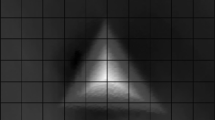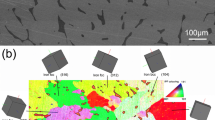Abstract
NiTi alloys have many engineering applications in microelectromechanical systems due to their super-elasticity and shape memory effect. Using nanoindentation technique, the effect of DC electric current on the nanoindentation behavior of superelastic NiTi wires with a composition of Ni: 55.8 wt%, Ti: balance, O2: ≤0.05 wt%, C: ≤0.05 wt% was studied for the current density in a range of 0 to 2.74 kA/cm2 and the indentation load in a range of 100 to 1500 μN. The reduced contact modulus increased with increasing electric current density for the current density larger than or equal to 1.32 kA/cm2. For the indentation load larger than or equal to 200 μN, the indentation hardness slightly increased with increasing electric current density. The indentation hardness decreased with increasing indentation load, showing the normal indentation size effect. A simple linear relation was derived between the indentation hardness and the square root of the ratio of indentation hardness to indentation load, which is supported by experimental results.










Similar content being viewed by others
References
Bellouard Y (2008) Shape memory alloys for microsystems: a review from a material research perspective. Mat Sci Eng Struct 481:582–589
Li J, Yang HL, Wang HF, Ruan JM (2014) Low elastic modulus titanium-nickel scaffolds for bone implants. Mat Sci Eng Mater 34:110–114
Ryhanen J, Kallioinen M, Serlo W, Peramaki P, Junila J, Sandvik P, Niemela E, Tuukkanen J (1999) Bone healing and mineralization, implant corrosion, and trace metals after nickel-titanium shape memory metal intramedullary fixation. J Biomed Mater Res 47:472–480
Choi E, Lee DH, Choei NY (2009) Shape memory alloy bending bars as seismic restrainers for bridges in seismic areas. Int J Steel Struct 9:261–273
Hartl DJ, Mooney JT, Lagoudas DC, Calkins FT, Mabe JH (2010) Use of a Ni60Ti shape memory alloy for active jet engine chevron application: II. Experimentally validated numerical analysis. Smart Mater Struct 19
Chen X, Peng XH, Chen B, Han J, Zeng ZM, Hu N (2014) Experimental investigation to thermal-mechanical behavior of Ni47Ti44Nb9 SMA under pure tension and pure torsion. J Alloy Compound 610:151–160
Yin H, He YJ, Sun QP (2014) Effect of deformation frequency on temperature and stress oscillations in cyclic phase transition of NiTi shape memory alloy. J Mech Phys Solids 67:100–128
Liu Y, Xie Z, Van Humbeeck J, Delaey L (1998) Asymmetry of stress-strain curves under tension and compression for NiTi shape memory alloys. Acta Mater 46:4325–4338
Grabe C, Bruhns OT (2008) Tension/torsion tests of pseudoelastic, polycrystalline NiTi shape memory alloys under temperature control. Mat Sci Eng Struct 481:109–113
Qian LM, Zhang S, Li DY, Zhou ZR (2009) Spherical indentation for determining the phase transition properties of shape memory alloys. J Mater Res 24:1082–1086
Yan WY, Amini A, Sun QP (2013) On anomalous depth-dependency of the hardness of NiTi shape memory alloys in spherical nanoindentation. J Mater Res 28:2031–2039
Su JF, Huang WM, Hong MH (2007) Indentation and two-way shape memory in a NiTi polycrystalline shape-memory alloy. Smart Mater Struct 16:S137–S144
Wood AJM, Clyne TW (2006) Measurement and modelling of the nanoindentation response of shape memory alloys. Acta Mater 54:5607–5615
Shastry VV, Ramamurty U (2013) Temperature dependence of indentation recovery ratios in austenitic and martensitic shape memory alloys. Smart Mater Struct 22:077002
Sinha A, Datta S, Chakraborti PC, Chattopadhyay PP (2013) Understanding the shape-memory behavior in Ti-(similar to 49 at. pct) Ni alloy by nanoindentation measurement. Metall Mater Trans A 44A:1722–1729
Zhang X, Xiong YY, Chen Y, Shao Y, Wu Z, Chen XN, Ge Y (2014) Investigation of shape memory alloy spring elastic coefficient based on varying applied currents in a cardiac assist device. J Mech Med Biol 14:1450048
Mineta T, Mitsui T, Watanabe Y, Kobayashi S, Haga Y, Esashi M (2002) An active guide wire with shape memory alloy bending actuator fabricated by room temperature process. Sens Actuators Phys 97–8:632–637
Zhao GF, Liu M, Yang FQ (2012) The effect of an electric current on the nanoindentation behavior of tin. Acta Mater 60:3773–3782
Yang FQ, Zhao GF (2010) Effect of electric current on nanoindentation of copper. Nanosci Nanotech Lett 2:322–326
Zhao GF, Yang FQ (2012) Effect of alternating electric current on the nanoindentation of copper. Appl Phys Mater Sci Proc 109:553–559
Yang FQ, Geng KB, Liaw PK, Fan GJ, Choo H (2007) Deformation in a Zr57Ti5CU20Ni8Al10 bulk metallic glass during nanoindentation. Acta Mater 55:321–327
Srinivasarao V, Jayaganthan R, Sekhar VN, Mohankumar, Tay AAO, Kripesh V (2004) Nanoindentation study of the sputtered Cu thin films for interconnect applications. IEEE Electron Packaging Tech Conf 343–347
Mei QS, Zhang L, Tsuchiya K, Gao H, Ohmura T, Tsuzaki K (2010) Grain size dependence of the elastic modulus in nanostructured NiTi. Scripta Mater 63:977–980
Sittner P, Landa M, Lukas P, Novak V (2006) R-phase transformation phenomena in thermomechanically loaded NiTi polycrystals. Mech Mater 38:475–492
Amini A, Yan WY, Sun QP (2011) Depth dependency of indentation hardness during solid-state phase transition of shape memory alloys. Appl Phys Lett 99:021901
Qian LM, Xiao XD, Sun QP, Yu TX (2004) Anomalous relationship between hardness and wear properties of a superelastic nickel-titanium alloy. Appl Phys Lett 84:1076–1078
Acknowledgments
Y.S. is grateful for the support of the Leading Academic Discipline Project of Shanghai Municipal Education Commission LADPSMEC through Grant No. J51902 and the Science Research Foundation of Shanghai Municipal Education Commission through Grant No. 11YZ269.
Author information
Authors and Affiliations
Corresponding author
Rights and permissions
About this article
Cite this article
Sun, Y., Zhao, G. & Yang, F. Effect of electric current on nanoindentation of superelastic NiTi alloy. Exp Mech 55, 1503–1509 (2015). https://doi.org/10.1007/s11340-015-0045-x
Received:
Accepted:
Published:
Issue Date:
DOI: https://doi.org/10.1007/s11340-015-0045-x




